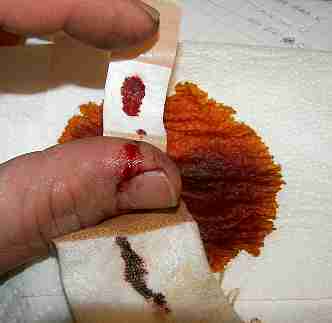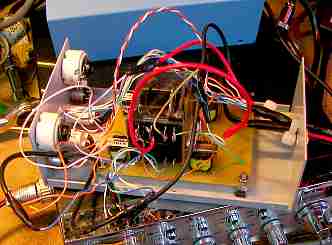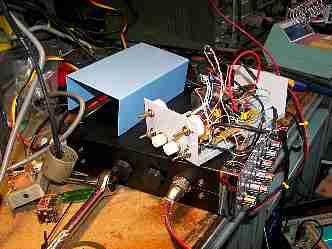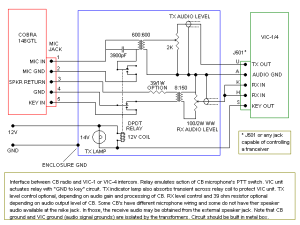Interface the VIC-1 or VIC-4 to the CB radio
page 1

safety first
|

|
proto lash-up. Pots and transformers are present for interfacing two radios. Only one relay is installed at this time, and only one interface is completed.

front panel. Upper pots control audio from CB to VIC. Lower pots control audio from VIC to CB mike input. Lights illuminate to show if radios are Keyed.
|

video of keying and text showing RF waveform. 7MB
|

done.
|

schematic of one channel.
|
Here is something I did with the VIC-4 that might be of interest. This gives transmit and receive function of a CB radio over to the VIC-1 or VIC-4 intercom system, just as if the CB were an RT524. To operate the CB normally, just unplug the adapter from the CB's mike jack and plug in the CB's mike. As with anything as grossly non-uniform as a CB radio, some changes might be necessary and your mileage may vary. The CB I use is an old-style pre-ST Cobra 148GTL. The interface box job is kind of messy looking but it was just a test case. Later this could be re-done with a better PCB and cabling.
Notes:
The headset of the VIC intercom system is driven directly from the military radio's headset amplifier. The impedance is 150 ohms. The 8:150 ohm transformer matches the CB audio output to the VIC-1. The typical CB however has alot more audio power (4 to 8 watts) than the RT524, so a series resistor on the 8 ohm side and a 'volume' control on the 150 ohm side help the level to be correct. Adjust to make the level with the CB receiving and producing a strong and undistorted audio signal to be the same loudness as the unsquelched RT524 noise.
The headset microphone drives the RT524 directly through the VIC-1. The level may be more than the CB will handle without distortion. Therefore the level control is used. On a good CB, the radio will have a microphone gain control and audio processing circuits, and this is less critical. Some cheap CBs may require more audio into the microphone input than the headset provides, this requires experimentation and an oscilloscope is handy.
The VIC keys the RT524 by grounding a key line. This is used here to control a relay that performs the same function as pushing the 'talk' switch on the CB mike. Note that many CBs use the switch to also disconnect the speaker during transmit. This is done because the speaker is otherwise connected to the CB's modulator and would feedback to the mike in the normal mode. The disconnect function is provided more for propriety than otherwise, and the VIC-x provides it again internally via its own relays.
The squelch on the CB should be set how you like. There is no provision for 'monitoring' (the "all' position on the VIC-1) but it could be done by adding a small additional amplifier with a 0-5V adjustable 150 ohm output inside the CB and feeding that to pin K of the VIC J501. This is made necessary since the CB has only one audio output, while the VRC-12 radio sets like the RT524 have two. In the schematic, the RX audio is shown going to pins K and H. This worked well with the VIC-4.
Transformers are used to isolate the CB from the VIC. The reasons are that the CB and VIC operate from different voltages and also it's very important to eliminate ground loops which would cause all kinds of noise and poor performance.
The 3900pF capacitor across the secondary winding of the transformer going to the CB microphone input is a bypass for RF. Since this system is installed in a truck with a shelter, there are alot of long cables running everywhere, and keying the headsets in the cab caused RF feedback due to the large antenna mounted on the bumper, and the RF cables running 4 feet away from, and parallel to, the audio cables.





